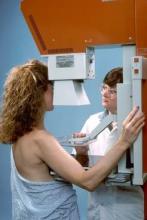Following United States Preventive Services Task Force mammography screening guidelines would save about $4.4 billion annually, without sacrificing quality of care, according to a study published online Feb. 3 in the Annals of Internal Medicine.
Taking the costs of mammography, computer-aided detection, recalls, biopsies, and other variables into account, the investigators estimated that it would have cost $3.5 billion to screen 85% of women in 2010 who met the USPSTF criteria: Screen women aged 50-74 years every other year, plus high-risk women aged 40-49 years and women aged 75-85 years with few comorbidities biennially (Ann. Intern. Med. 2014 Feb. 3;160:145-53 [doi:10.7326/M13-1217]).
Instead, $7.8 billion was actually spent in 2010 to screen just 70% of women using the mélange of screening practices in place today in the United States, a byproduct of the country’s uncertainty about the right way to proceed, the researchers noted.
Meanwhile, following the advice of the American Cancer Society and other groups for annual screenings of women aged 40-84 years would have cost $10.1 billion if 85% had come into the clinic. Screening 85% of women aged 50-69 years biennially – in keeping with the European approach – would have cost $2.6 billion.
Previous studies have found fewer false-positives and recalls with biennial screening, and no significant increase in late-stage cancer detections, said Dr. Cristina O’Donoghue of the University of Illinois at Chicago and her associates.
"Following mammography screening guidelines, such as those from the USPSTF, [which] optimize frequency on the basis of best-available evidence will ... improve screening and save billions of dollars," money that’s better spent on expanding mammography access and increasing risk-based screening, breast-cancer prevention, and mammography reading by experts less likely to make mistakes, among other things, the researchers said.
Even so, "in the United States, there has been resistance to reducing frequency or modifying the age-range for mammography. Those who advocate annual screening should justify the increased costs of nearly $7 billion per year, compared with biennial policies," they said.
The project was a modeling exercise to price out various approaches to breast cancer screening using Medicare reimbursement rates; census figures; Breast Cancer Surveillance Consortium records; and other data sources. The researchers stated that they thought the cost information would help doctors, women, and policy makers find the right approach, especially as the Affordable Care Act improves mammography access and increases screening rates.
The U.S. task force’s biennial approach "is in line with our national goals of advancing health care delivery while improving cost-efficiency," the researchers said.
They concluded that screening frequency is the main driver of costs in mammography, followed by the percentage of women screened, cost per screen, percentage of women screened with digital mammography, and percentage of mammography recalls.
The researchers had no financial conflicts to disclose. The study was funded by the University of California and the Safeway Foundation.



